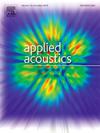A broadband acoustic waveguide cloak based on the gradient impedance boundaries
IF 3.4
2区 物理与天体物理
Q1 ACOUSTICS
引用次数: 0
Abstract
Invisibility cloaking is a longstanding research topic due to its significant applications in various human activities like communication, manufacturing and aerospace, etc. In this paper, we theoretically design and experimentally demonstrated a broadband acoustic waveguide cloak for acoustic waves in air, which is composed of a straight waveguide coated with two gradient impedance boundaries (GIBs). When the plane wave (PW) incidents into the waveguide, it exercises a mode conversion of PW-surface wave (SW)-PW. As SWs are confined by GIBs, obstacles in the waveguide between the confined SWs become invisible to the incident PW with negligible reflection. Thus, an acoustic waveguide cloak is obtained. The experiments demonstrate the negligible reflection (<5 %) in the waveguide coated with GIBs, i.e., in our proposed acoustic waveguide cloak from 2.62 kHz to 3.74 kHz. However, in the same frequencies, the incident PW is almost totally reflected (>98 %) in the waveguide without GIBs. It agrees well with the simulation results and the theoretical predictions. Thus, a broadband acoustic waveguide cloak is obtained. In addition, the acoustic waveguide cloak is also demonstrated in the waveguides with sharp bends and corners, such as the L-shaped and the U-shaped waveguides. Our proposal may provide a strong candidate for acoustic wave manipulation and acoustic functional devices.
求助全文
约1分钟内获得全文
求助全文
来源期刊

Applied Acoustics
物理-声学
CiteScore
7.40
自引率
11.80%
发文量
618
审稿时长
7.5 months
期刊介绍:
Since its launch in 1968, Applied Acoustics has been publishing high quality research papers providing state-of-the-art coverage of research findings for engineers and scientists involved in applications of acoustics in the widest sense.
Applied Acoustics looks not only at recent developments in the understanding of acoustics but also at ways of exploiting that understanding. The Journal aims to encourage the exchange of practical experience through publication and in so doing creates a fund of technological information that can be used for solving related problems. The presentation of information in graphical or tabular form is especially encouraged. If a report of a mathematical development is a necessary part of a paper it is important to ensure that it is there only as an integral part of a practical solution to a problem and is supported by data. Applied Acoustics encourages the exchange of practical experience in the following ways: • Complete Papers • Short Technical Notes • Review Articles; and thereby provides a wealth of technological information that can be used to solve related problems.
Manuscripts that address all fields of applications of acoustics ranging from medicine and NDT to the environment and buildings are welcome.
 求助内容:
求助内容: 应助结果提醒方式:
应助结果提醒方式:


